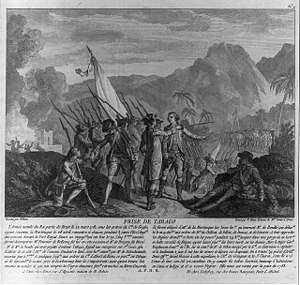Invasion of Tobago
The Invasion of Tobago was a French invasion of the British-held island of Tobago during the Anglo-French War. On May 24, 1781, the fleet of Comte de Grasse landed troops on the island under the command of General Marquis de Bouillé. By June 2, 1781, they had successfully gained control of the island.
Background
In March 1781, France sent a large fleet consisting of 20 ships of the line and a convoy with 6,000 troops to the West Indies under the command of de Grasse. They arrived off the coast of Martinique on 28 April. The French drove off the British fleet led by Sir Samuel Hood, which had been blocking Fort Royal. Hood and the British station commander Admiral George Brydges Rodney joined forces on May 11, 1781 between St. Kitts and Antigua to discuss the French threat.
De Grasse met with Martinique's governor, Marquis de Bouillé, and developed a plan for capturing Tobago. The French forces were to be divided, with one convoy accompanied by a small number of battle ships to head for Tobago, with the rest of the forces to land on St. Lucia as a diversion. The forces used in the diversion would then be withdrawn and sent to Tobago, reinforcing the first convoy.
Led by de Bouillé and accompanied by de Grasse, the St. Lucia platoon withdrew from Martinique on May 8, 1781. The Tobago-bound platoon, led by Blanchelande and accompanied by two ships of the line and a number of frigates, departed on May 9, 1781.
Attack on St. Lucia
Bouillé's force, numbering between 1,200 and 1,500, landed at Gros Islet, a village at the northern tip of St. Lucia, early on May 10. They surprised the small British garrison there, taking about 100 prisoners and seizing military supplies. This prompted General Anthony St Leger, the island's lieutenant governor, to organise the defence of Castries and fortify the slopes of Morne Fortune above that port.
Two nights later, the French troops reembarked on the transports, and the fleet sailed off to the windward for several days before returning to Martinique on May 15. Troops numbering 3,000 were then embarked, and the fleet sailed for Tobago on May 25.
Rodney was alerted to the landing, but rather than sailing his whole fleet to St. Lucia, he sailed for Barbados, detaching only a few smaller ships to the island's aid. He was not informed of the French withdrawal from St. Lucia until he was en route to Barbados, which he reached on May 23.
Invasion of Tobago
On May 24, the detachment of General Blanchelande arrived at Tobago. Under cover fire from the Pluton and the Experiment, his troops landed near the port of Scarborough. They quickly overran the town's forts, and Governor George Ferguson led his remaining forces into the hills. These forces, three to four hundred regulars and four to five hundred militia, established a strong position fortified by cannons on the interior ridge. Blanchelande followed, but decided to wait for reinforcements rather than attack the position.
Rodney learned of the attack on Tobago on May 27, while at Barbados. He detached Francis Samuel Drake and six ships of the line and some troops on May 29 to provide relief to Ferguson, only to learn on June 2 that de Grasse's fleet (20 ships of the line) had arrived and chased Drake away. De Grasse had arrived at Tobago on May 30; Drake, greatly outnumbered, retreated, losing only one small ship. De Grasse then landed troops on both sides of the island the next day, and Bouillé made a junction with Blanchelande outside the British line of defence. They decided to attack the next day.
With the arrival of French reinforcements, Ferguson decided to abandon his position, and began a retreat that night. The French gave chase the following morning when they saw that the British lines had been abandoned. It was a sweltering, hot day, and both columns had men drop out due to the conditions; a number of the retreating British were captured. By the end of the day, Ferguson realised the situation was hopeless, and opened negotiations for terms of surrender. Under the agreed terms, Ferguson's forces surrendered on June 2.
Aftermath
Rodney learned of Ferguson's surrender on June 4, and immediately sailed out from Barbados. When he finally spotted de Grasse's fleet, the latter was sailing for Grenada with 24 ships of the line to Rodney's 20; Rodney decided to avoid action, claiming later that he was concerned that chasing de Grasse would have left him to leeward, with de Grasse then free to attack Barbados.
When Ferguson reached London, he and Rodney engaged in a highly public war of words over Rodney's failure to relieve the island in a timely manner.
De Grasse, after Rodney called off his chase, returned to Tobago, embarked some of the troops, and returned to Martinique. He then sailed in July for Cap-Français, where he was met by a dispatch from the North American fleet, whose news prompted him to sail north to support operations on the Chesapeake Bay that culminated in the pivotal Battle of the Chesapeake and Siege of Yorktown.
The island of Tobago remained in French hands under the terms of the 1783 Treaty of Paris that ended the war; it was again fought over during the Napoleonic Wars, and fell definitively under British control with the 1814 Treaty of Paris.
References
- De Grasse, François Joseph Paul. The Operations of the French fleet under the Count de Grasse in 1781-2
- Colomb, Philip Howard. Naval warfare, its ruling principles and practice historically treated
- Lewis, Charles. Admiral de Grasse and American Independence
- Southey, Thomas. Chronological history of the West Indies: in Three Volumes Volume 2 (contains Governor Ferguson's statement on the invasion)
